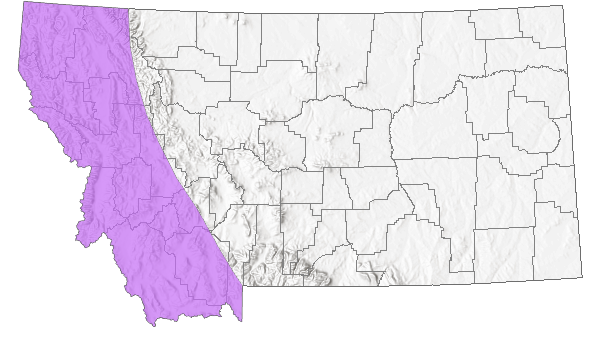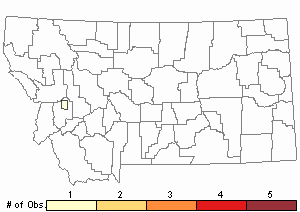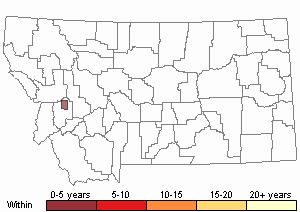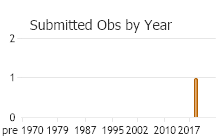View in other NatureServe Network Field Guides
NatureServe
Montana
Utah
Wyoming
Idaho
Wisconsin
British Columbia
South Carolina
Yukon
California
New York
Square-dotted Blue - Euphilotes battoides
General Description
[From Ferris and Brown 1981; Scott 1986; Opler and Wright 1999; Glassberg 2001; Pyle 2002] Forewing 1.1-1.3 cm. Forewing fringe white with black checkers. Uppersurface of males blue with black outer margin with or without trace of orange aurora on hindwing outer margin, females brown often with orange aurora on hindwing outer margin. Undersurface gray-white with black spotting heavy and squarish (more so on forewing), hindwing orange submarginal band usually of bold and fused spots, lacking distal submarginal metallic scales.
Phenology
One flight; June to July for the glaucon subspecies (Scott 1986). Late May to early August for the glaucon subspecies (Glassberg 2001). July to September in the Rocky Mountain states (Ferris and Brown 1981), late March to early August in Oregon and Washington (Pyle 2002), mid-June to early August in Oregon (Warren 2005), mid-May to late July in British Columbia (Guppy and Shepard 2001).
Diagnostic Characteristics
Difficult to distinguish in field from Euphilotes ancilla based on external characters; data on flight date, exact locality, larval hostplant very useful, and determination may ultimately require genitalia dissection (Glassberg 2001; Guppy and Shepard 2001). Helpful characteristics include presence of the submarginal orange aurora on both surfaces of the hindwing, on the undersurface the orange aurora usually bold with fused spots and lacking distal submarginal metallic scales; wing fringes white and checkered, undersurface suffused basally with gray, forewing undersurface with prominent black spots squarish, somewhat larger than on forewing.
Species Range
Montana Range
Range Descriptions

 Native
Native
Range Comments
Southern British Columbia south to southern California, east to western Montana, southwestern Idaho, southwestern Colorado, western new Mexico (Opler and Wright 1999); 1524 m to 2896 m elevation in Colorado (Brown 1957; Scott and Scott 1978), 1830 m to 2592 m elevation elsewhere in the Rocky Mountain states (Ferris and Brown 1981), 914 m to 2134 m elevation in Oregon (Warren 2005), 1500 m to 2200 m elevation in British Columbia (Guppy and Shepard 2001). In Montana, reported from six counties (Beaverhead, Jefferson, Lincoln, Madison, Missoula, Ravalli) in the western 1/5 of the state (Kohler 1980; Stanford and Opler 1993; FLMNH Lepidopterists' Society database; Butterflies and Moths of North America database). Uncommon to locally common in the Pacific Northwest for the glaucon subspecies (Glassberg 2001).
Observations in Montana Natural Heritage Program Database
Number of Observations: 1
(Click on the following maps and charts to see full sized version)
Map Help and Descriptions
Relative Density

Recency


 (Observations spanning multiple months or years are excluded from time charts)
(Observations spanning multiple months or years are excluded from time charts)
Migration
Non-migratory.
Habitat
Open habitats such as coastal dunes, sagebrush-steppe, desert canyons, open woodland, dry slopes and hillsides, exposed ridges, above treeline in alpine terrain (Scott 1986; Opler and Wright 1999; Glassberg 2001; Pyle 2002). Habitat in Montana not described, but probably similar.
Food Habits
Larval food plants include at several species of Eriogonum (Scott 1986, 1992, 2006; Matonni 1988; Pyle 2002; Warren 2005), at least five of which (E. flavum, heracloides, ovalifolium, sphaerocephalum, umbellatum) are larval food plants for Euphilotes battoides glaucon, the subspecies which occurs in Montana. Adults feed on flower nectar (especially Eriogonum), dung, and mud (Scott 2014).
Reproductive Characteristics
Females lay eggs singly on host plant flowers (Scott 1986, 1992, 2006). Eggs hatch in about 5 days, reach L4 instar and pupate in about 30 days after oviposition. Larvae solitary, feed on flowers and fruits, build no nests, overwinters in litter or soil as pupae (Scott 1979, 1986; James and Nunnallee 2011). Larvae-ant association apparently not yet reported but likely, as has been documented for other species of Euphilotes (Ballmer and Pratt 1991). Males patrol throughout the day near host plants in search of females (Scott 1975b, 1986).
Stewardship Responsibility
References
- Literature Cited AboveLegend:
 View Online Publication
View Online Publication Ballmer, G.R. and G.F. Pratt. 1991. Quantification of ant attendance (myrmecophily) of lycaenid larvae. Journal of Research on the Lepidoptera 30(1-2): 95-112.
Ballmer, G.R. and G.F. Pratt. 1991. Quantification of ant attendance (myrmecophily) of lycaenid larvae. Journal of Research on the Lepidoptera 30(1-2): 95-112. Brown, F.M. 1957. Colorado Butterflies. Proceedings; Numbers Three through Seven. Denver Museum of Natural History, Denver, Co.
Brown, F.M. 1957. Colorado Butterflies. Proceedings; Numbers Three through Seven. Denver Museum of Natural History, Denver, Co. Ferris, C.D. and F.M. Brown (eds). 1981. Butterflies of the Rocky Mountains. Univ. of Oklahoma Press. Norman. 442 pp.
Ferris, C.D. and F.M. Brown (eds). 1981. Butterflies of the Rocky Mountains. Univ. of Oklahoma Press. Norman. 442 pp. Glassberg, J. 2001. Butterflies through Binoculars: A Field Guide to the Butterflies of Western North America. Oxford University Press.
Glassberg, J. 2001. Butterflies through Binoculars: A Field Guide to the Butterflies of Western North America. Oxford University Press. Guppy, C.S. and J.H. Shepard. 2001. Butterflies of British Columbia: including western Alberta, southern Yukon, the Alaska Panhandle, Washington, northern Oregon, northern Idaho, northwestern Montana. UBC Press (Vancouver, BC) and Royal British Columbia Museum (Victoria, BC). 414 pp.
Guppy, C.S. and J.H. Shepard. 2001. Butterflies of British Columbia: including western Alberta, southern Yukon, the Alaska Panhandle, Washington, northern Oregon, northern Idaho, northwestern Montana. UBC Press (Vancouver, BC) and Royal British Columbia Museum (Victoria, BC). 414 pp. James, D.G. and D. Nunnallee. 2011. Life histories of Cascadia butterflies. Corvallis, OR: Oregon State University Press. 447 p.
James, D.G. and D. Nunnallee. 2011. Life histories of Cascadia butterflies. Corvallis, OR: Oregon State University Press. 447 p. Kohler, S. 1980. Checklist of Montana Butterflies (Rhopalocera). Journal of the Lepidopterists' Society 34(1): 1-19.
Kohler, S. 1980. Checklist of Montana Butterflies (Rhopalocera). Journal of the Lepidopterists' Society 34(1): 1-19. Mattoni, R.H.T. 1988. The Euphilotes battoides complex: recognition of a species and description of a new subspecies (Lycaenidae). Journal of Research on the Lepidoptera 27(3-4):173-185.
Mattoni, R.H.T. 1988. The Euphilotes battoides complex: recognition of a species and description of a new subspecies (Lycaenidae). Journal of Research on the Lepidoptera 27(3-4):173-185. Opler, P.A. and A.B. Wright. 1999. A field guide to western butterflies. Second edition. Peterson Field Guides. Houghton Mifflin Company, Boston, Massachusetts. 540 pp.
Opler, P.A. and A.B. Wright. 1999. A field guide to western butterflies. Second edition. Peterson Field Guides. Houghton Mifflin Company, Boston, Massachusetts. 540 pp. Pyle, R.M. 2002. The butterflies of Cascadia: a field guide to all the species of Washington, Oregon, and surrounding territories. Seattle Audubon Society, Seattle, Washington. 420 pp.
Pyle, R.M. 2002. The butterflies of Cascadia: a field guide to all the species of Washington, Oregon, and surrounding territories. Seattle Audubon Society, Seattle, Washington. 420 pp. Scott, J.A. 1975b. Mate-locating behavior of western North American butterflies. Journal of Research on the Lepidoptera 14:1-40.
Scott, J.A. 1975b. Mate-locating behavior of western North American butterflies. Journal of Research on the Lepidoptera 14:1-40. Scott, J.A. 1979. Hibernal diapause of North American Papilionoidea and Hesperioidea. Journal of Research on the Lepidoptera 18(3): 171-200.
Scott, J.A. 1979. Hibernal diapause of North American Papilionoidea and Hesperioidea. Journal of Research on the Lepidoptera 18(3): 171-200. Scott, J.A. 1986. The butterflies of North America: a natural history and field guide. Stanford University Press, Stanford, California.
Scott, J.A. 1986. The butterflies of North America: a natural history and field guide. Stanford University Press, Stanford, California. Scott, J.A. 1992. Hostplant records for butterflies and skippers (mostly from Colorado) 1959-1992, with new life histories and notes on oviposition, immatures, and ecology. Papilio new series #6. 185 p.
Scott, J.A. 1992. Hostplant records for butterflies and skippers (mostly from Colorado) 1959-1992, with new life histories and notes on oviposition, immatures, and ecology. Papilio new series #6. 185 p. Scott, J.A. 2006. Butterfly hostplant records, 1992-2005, with a treatise on the evolution of Erynnis, and a note on new terminology for mate-locating behavior. Papilio new series #14. 74 p.
Scott, J.A. 2006. Butterfly hostplant records, 1992-2005, with a treatise on the evolution of Erynnis, and a note on new terminology for mate-locating behavior. Papilio new series #14. 74 p. Scott, J.A. 2014. Lepidoptera of North America 13. Flower visitation by Colorado butterflies (40,615 records) with a review of the literature on pollination of Colorado plants and butterfly attraction (Lepidoptera: Hersperioidea and Papilionoidea). Contributions of the C.P. Gillette Museum of Arthopod Diversity. Fort Collins, CO: Colorado State University. 190 p.
Scott, J.A. 2014. Lepidoptera of North America 13. Flower visitation by Colorado butterflies (40,615 records) with a review of the literature on pollination of Colorado plants and butterfly attraction (Lepidoptera: Hersperioidea and Papilionoidea). Contributions of the C.P. Gillette Museum of Arthopod Diversity. Fort Collins, CO: Colorado State University. 190 p. Scott, J.A. and G.R. Scott. 1978. Ecology and distribution of the butterflies of southern central Colorado. Journal of Research on the Lepidoptera 17(2): 73-128.
Scott, J.A. and G.R. Scott. 1978. Ecology and distribution of the butterflies of southern central Colorado. Journal of Research on the Lepidoptera 17(2): 73-128. Stanford, R.E. and P.A. Opler. 1993. Atlas of western USA butterflies: including adjacent parts of Canada and Mexico. Unpubl. Report. Denver and Fort Collins, Colorado 275 pp.
Stanford, R.E. and P.A. Opler. 1993. Atlas of western USA butterflies: including adjacent parts of Canada and Mexico. Unpubl. Report. Denver and Fort Collins, Colorado 275 pp. Warren, A.D. 2005. Lepidoptera of North America 6: Butterflies of Oregon, their taxonomy, distribution, and biology. Contributions of the C. P. Gillette Museum of Arthropod Diversity, Colorado State University. Fort Collins, Colorado. 406 pp.
Warren, A.D. 2005. Lepidoptera of North America 6: Butterflies of Oregon, their taxonomy, distribution, and biology. Contributions of the C. P. Gillette Museum of Arthropod Diversity, Colorado State University. Fort Collins, Colorado. 406 pp.
- Additional ReferencesLegend:
 View Online Publication
View Online Publication
Do you know of a citation we're missing? Allen, T.J., J.P. Brock, and J. Glassberg. 2005. Caterpillars in the field and garden: a field guide to the butterfly caterpillars of North America. Oxford University Press.
Allen, T.J., J.P. Brock, and J. Glassberg. 2005. Caterpillars in the field and garden: a field guide to the butterfly caterpillars of North America. Oxford University Press. Brock, J.P. and K. Kaufman. 2003. Kaufman Field Guide to Butterflies of North America. Houghton Mifflin Company, New York, NY 284 pp.
Brock, J.P. and K. Kaufman. 2003. Kaufman Field Guide to Butterflies of North America. Houghton Mifflin Company, New York, NY 284 pp. Forister, M.L., C.A. Halsch, C.C. Nice, J.A. Fordyce, T.E. Dilts, J.C. Oliver, K.L. Prudic, A.M. Shapiro, J.K. Wilson, J. Glassberg. 2021. Fewer butterflies seen by community scientists across the warming and drying landscapes of the American West. Science 371:1042-1045.
Forister, M.L., C.A. Halsch, C.C. Nice, J.A. Fordyce, T.E. Dilts, J.C. Oliver, K.L. Prudic, A.M. Shapiro, J.K. Wilson, J. Glassberg. 2021. Fewer butterflies seen by community scientists across the warming and drying landscapes of the American West. Science 371:1042-1045. Forister, M.L., E.M. Grames, C.A. Halsch, K.J. Burls, C.F. Carroll, K.L. Bell, J.P. Jahner, et al. 2023. Assessing risk for butterflies in the context of climate change, demographic uncertainty, and heterogeneous data sources. Ecological Monographs 93(3):e1584. https://doi.org/10.1002/ecm.1584
Forister, M.L., E.M. Grames, C.A. Halsch, K.J. Burls, C.F. Carroll, K.L. Bell, J.P. Jahner, et al. 2023. Assessing risk for butterflies in the context of climate change, demographic uncertainty, and heterogeneous data sources. Ecological Monographs 93(3):e1584. https://doi.org/10.1002/ecm.1584 Layberry, R.A., P.W. Hall, and J.D. LaFontaine. 1998. The Butterflies of Canada. University of Toronto Press. 280 pp. + color plates.
Layberry, R.A., P.W. Hall, and J.D. LaFontaine. 1998. The Butterflies of Canada. University of Toronto Press. 280 pp. + color plates.
- Web Search Engines for Articles on "Square-dotted Blue"
- Additional Sources of Information Related to "Insects"





